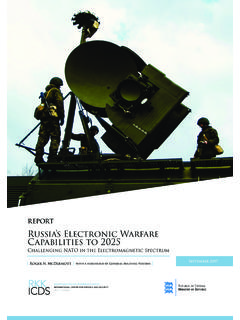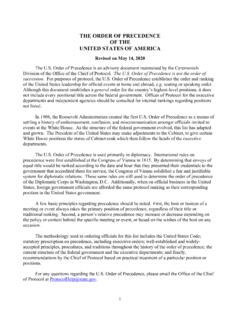Transcription of The Belarusian Armed Forces
1 August 2021 The Belarusian Armed Forces Structures, Capabilities, and Defence Relations with Russia| Konr ad Muzyk a | A nalysisThe Belarusian Armed ForcesIITitle: The Belarusian Armed Forces : Structures, Capabilities, and Defence Relations with RussiaAuthor: Muzyka, KonradPublication date: August 2021 Category: AnalysisCover page photo: President Lukashenko speaks during a parade marking the 75th anniversary of the Victory of the Soviet people in the Great Patriotic War, May 2020. Photo credit: Press Service of the President of the Republic of Belarus, : Armed Forces of Belarus, Belarus-Russia defence cooperationDisclaimer: The views and opinions contained in this analysis are those of its author only and do not necessarily represent the positions of the International Centre for Defence and Security or any other 2228-2076 International Centre for Defence and Security 63/4 Narva Rd.
2 , 10120 Tallinn, Estonia Belarusian Armed ForcesIIAbout the AuthorKonr ad Muzyk aKonrad Muzyka is an independent defence analyst and the Director of Rochan Consulting, which provides consultancy and advisory services on the Russian and Belarusian Armed Forces . He holds an MA in Russian Studies from the School of Slavonic and East European Studies at University CollegeLondon. Between 2012 and 2019, Konrad worked at Jane s as a military capabilities analyst, focusingon military developments in Central Europe and the post-Soviet Belarusian Armed ForcesIIIAck nowledgementsThe author would like to thank Polish defence analyst Rafa Zaniewski for his help in writing Chapter 1 on the structure and capabilities of the Belarusian Armed Belarusian Armed ForcesIVList of Abbr evi ationsAADC Air and Air Defence CommandAPC Armoured Personnel CarrierBAF Belarusian Armed ForcesCBRN Chemical, Biological.
3 Radiological and NuclearCEP Circular Error ProbableEW Electronic WarfareGDP Gross Domestic ProductIFV Infantry Fighting VehicleMLRS Multiple Launch Rocket SystemMoD Ministry of DefenceRGF Regional Group of ForcesSAM Surface-to-Air MissileSAP State Armaments ProgrammeSOF Special Operations ForcesSPG Self-Propelled GunSPH Self-Propelled HowitzerTEL Transporter Erector LauncherVKS Russian Aerospace Forces (Vozdushno-kosmicheskiye sily)1 The Belarusian Armed ForcesIntroductionThe Belarusian Armed Forces (BAF) were created in May 1992 when the Soviet Belarusian Military district was dissolved.
4 The Main Staff (a precursor of the current General Staff) and the Ministry of Defence (MoD) were subsequently established to manage the remnants of what had been one of the most militarised military districts of the Soviet the Cold War, units stationed in the Belarusian Soviet Socialist Republic were tasked with being a spearhead that would, had a conflict broken out, push through NATO s defences in Germany. This mission necessitated the sustainment of a very large military presence equipped with the most modern hardware fielded by Warsaw Pact Forces .
5 At the end of 1991, the Soviet Union had approximately 24 500 tactical and strategic nuclear warheads deployed on the territories of Belarus, Russia, Ukraine, and Those on the territory of Belarus alone would have equated to the sixth-largest nuclear arsenal in the world. A quarter of the Soviet Topol (SS-25) intercontinental ballistic missiles were deployed in Robbert S. Norris and Hans M. Kristensen, Global nuclear weapons inventories, 1945 2010, Bulletin of the Atomic Scientists, vol 66, no. 4 (2010), Irina Pimoshenko, Белорусско-Российские Военные Отношения: От Нейтралитета До Коллективной Безопасности [ Belarusian -Russian Military Relations: From Neutrality to Collective Security], Белорусский журнал международного права и международных отношений [ Belarusian Journal of International Law and International Relations], no.
6 3, personnel returning from the German Democratic Republic further inflated military numbers in Belarus. By the early 1990s, it had become the country with the highest concentration of military Forces in the world, with a ratio of one military personnel per 43 Today, Belarus claims that it firmly adheres to a peace-loving policy and retains the status of a security donor in the region, and that the Belarusian Army has never threatened anyone, does not threaten and is not going to threaten. 4 This narrative, presenting Belarus as a benign actor in the regional security architecture, has been pushed by Minsk for years, if not decades.
7 It is partly true: the BAF s capabilities are insufficient for conducting independent, combined arms military operations; and Belarus does not train for such operations on its But this security assessment does not reflect changes that have recently occurred in Minsk s foreign policy. Belarus relationship with the West has deteriorated sharply, in particular after Minsk s violent repression of the anti-government protests that followed the August 2020 election, while its co-operation with Russia has grown and continues to deepen across different s ever closer defence relationship with Moscow could propel Belarus into a more belligerent posture in the region.
8 This 3 Ra fa Czachor, Bia oruska polityka neutralno ci i bezatomowo ci w latach 90 [ Belarusian policy of neutrality and atomicity in the 90s], Zeszyty Naukowe Dolno l skiej Wy szej Szko y Przedsi biorczo ci i Techniki [Scientific Papers of the Lower Silesian University of Entrepreneurship and Technology], no. 4, 2011, Лукашенко утвердил новый план обороны Беларуси. На чем сделаны акценты? [Lukashenko approved a new plan for the defence of Belarus. What are the highlights?], Belta, 19 December 2019. 5 In August 2020, the BAF conducted the largest readiness exercise in its history.
9 Officially almost all military units were mobilised and deployed from their bases. However, analyses of satellite imagery and videos posted on social media indicated exercises at company- and battalion-level only. Konrad Muzyka, IMINT Analysis Grodno Training Range, Rochan Consulting, 27 August 2020; Konrad Muzyka, Mobilisation of the Belarusian Armed Forces , Rochan Consulting, 25 August the early 1990s, Belarus had become the country with the highest concentration of military Forces in the world2 The Belarusian Armed Forceswould not necessarily mean a more intensive modernisation effort or an increase in the size of the BAF it seems that the political leadership is content with their current state, even if their Russian counterparts are not.
10 Minsk would look to Moscow to provide any significant capability enhancements. But Lukashenko seems no longer to have room for manoeuvre or opportunities to postpone Russian attempts to further integrate the two it is, Belarus defence cooperation with Russia already spans all levels of defence planning and includes tactical, operational, and strategic aspects. The entire Belarusian ground and special Forces are part of a Regional Group of Forces (RGF) with Russia s 1st Guards Tank Army, an arrangement that in wartime would effectively put them under the command of Russia s Joint Strategic Command West (via the Belarusian General Staff).








